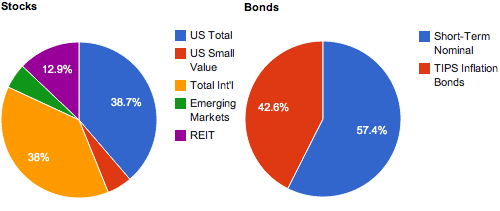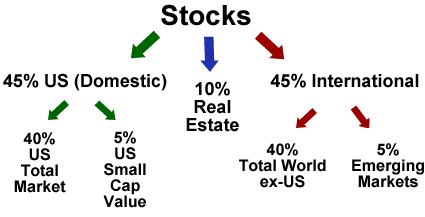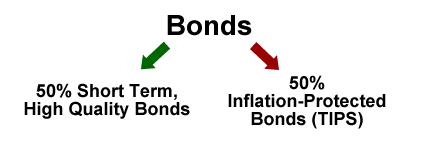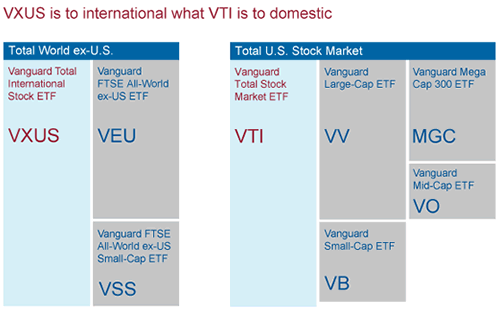Here’s a mid-year update of our investment portfolio, including employer 401(k) plans, self-employed retirement plans, Traditional and Roth IRAs, and taxable brokerage holdings. Cash reserves (emergency fund), college savings accounts, and day-to-day cash balances are excluded.
Asset Allocation & Holdings
Here is my current actual asset allocation:

The overall target asset allocation remains the same, based on my own preferences and research:


I pick asset classes that are likely to provide a long-term return above inflation, as well as offer some historical tendencies to be less correlated to each other. I don’t hold commodities futures or gold because I am not comfortable with them enough to know that I will hold them through an extended period of underperformance (and if you don’t do that, there’s no point). Despite the market volatility, I still try to buy, hold, and rebalance.
Our current ratio is about 75% stocks and 25% bonds. Specific ticker holdings are below. I’ve shifted some money in the PIMCO Total Return Institutional Fund because it’s the only bond fund in our employer 401(k) and I’m running out of tax-deferred space for bonds. At least the expense ratio is 0.46%, not as bad as it could be.
Also, I’ve switched from Vanguard FTSE All-World ex-US ETF (VEU) to the Vanguard Total International fund (VXUS) for tax-loss harvesting reasons and also because VXUS is more complete as it holds more stocks, including small-cap international companies whereas VEU does not. Here’s a visualization:

Stock Holdings
Vanguard Total Stock Market Fund (VTI, VTSMX)
Vanguard Small-Cap Value Index Fund (VISVX)
Vanguard Total International Stock Market Fund (VXUS, VGTSX)
Vanguard MSCI Emerging Markets Fund (VWO, VEIEX)
Vanguard REIT Index Fund (VNQ, VGSIX)
Bond Holdings
Vanguard Limited-Term Tax-Exempt Fund (VMLTX)
PIMCO Total Return Institutional* (PTTRX)
Stable Value Fund* (3% yield on most, 1.25-1.8% yield on rest)
iShares Barclays TIPS Bond ETF (TIP)
Individual TIPS securities
The overall expense ratio for this portfolio is in the neighborhood of .20% annually, or 20 basis points, which is much lower hurdle to overcome than the average mutual fund expense ratio of over 1% annually. This is all DIY, so I don’t pay portfolio management or financial advisor fees.
Early Retirement Progress
To measure our progress towards total financial independence, I use a 3% theoretical withdrawal rate and compare that with our expected future expenses. This is lower than the common 4% withdrawal rate because we intend to retire early and our money may have to last much longer than most (50+ years). This results in a goal of 33 times our expected annual spending. Currently, our portfolio would theoretically cover 54% of our expected expenses.
The 3% withdrawal rate is simply a rule-of-thumb. In terms of actual implementation, I’ve been thinking about a more dividend-oriented withdrawal approach, but right now I’m just gathering information.
 The Best Credit Card Bonus Offers – 2025
The Best Credit Card Bonus Offers – 2025 Big List of Free Stocks from Brokerage Apps
Big List of Free Stocks from Brokerage Apps Best Interest Rates on Cash - 2025
Best Interest Rates on Cash - 2025 Free Credit Scores x 3 + Free Credit Monitoring
Free Credit Scores x 3 + Free Credit Monitoring Best No Fee 0% APR Balance Transfer Offers
Best No Fee 0% APR Balance Transfer Offers Little-Known Cellular Data Plans That Can Save Big Money
Little-Known Cellular Data Plans That Can Save Big Money How To Haggle Your Cable or Direct TV Bill
How To Haggle Your Cable or Direct TV Bill Big List of Free Consumer Data Reports (Credit, Rent, Work)
Big List of Free Consumer Data Reports (Credit, Rent, Work)
I think you forgot to post the actual performance of your portfolio.
I don’t know the exact portfolio performance, I’m sure somebody could calculate it from the respective mutual fund tickers. The exact performance doesn’t matter to me, as it’s all passively indexed and I wouldn’t change anything in response to short-term performance numbers anyway. If anything, I’ll start calculating the dividend and interest income the portfolio would have produced over the last rolling 12 months.
I don’t trust the broad market anymore, price has gone up and down with minimal return. I’d rather own a basket of quality blue chip stocks with dividend growth.
Jonathan, please help understand the below:
When you say “overall expense ratio for this portfolio is in the neighborhood of .20% annually” how is it different from the expense ratio of 0.19% annually for the Vanguard Target retirement 2045 fund. In fact all the changes you make to your portfolio actively is done by Vanguard fund managers at almost the same cost. Why is managing portfolio oneself (like you do) better than what Vanguard would do it for you? Any insight into this would be helpful.
VTSMX/VTI actually holds everything which VGSIX/VNQ holds. Why the conscious decision to overweight the sector relative to the index? Beta?
Jonathan…
My personal experience leads me to believe that withdrawal rate is a poor measure of financial independence almost to the point of irrelevancy. In fact, yield on your portfolio is almost secondary to the key factor of managing expenses. I think its essential to consider how you can match expenses with revenue regardless of what your returns are. In other words; determining in which countries you can be economically viable? Can your investments for instance ever be safe or withstand the onslaught of the US Medical Industry Mafia? Are there places that you can live easily with no automobile, where are weather patterns that will reduce utility costs, etc.
I believe answering those questions are the key, you can make money by making money, and make money, so to speak by not spending as much money, the latter being far easer right now.
Any reason you don’t get Total Bond Market Index (VBMFX)?
Thanks for the semi-annual update!
I’d like to hear more about how you calculated your expected retirement expenses. Also, when are you targeting? I was recently reading about the options for retiring before age 59 1/2, and I couldn’t figure out a good way to do it without tax penalties. It actually left me feeling a little depressed.
@Rajeev – First, I like Vanguard Target Funds, But there are a number of reasons to DIY, here’s two:
1. Tax-efficiency. Having all your bonds and stocks wrapped up in one fund makes it difficult for tax-efficient placement of asset classes. See here:
https://www.mymoneyblog.com/archives/2007/02/tax-efficient-mutual-fund-placement-for-maximum-return.html
2. Limited selections. If you have other assets like annuities or 401ks with limited choices, then you’re going to have to adjust your Target fund to make the overall picture look right. I’d rather just use separate moving parts.
@Andrew – I choose to overweight REITS because I believe they are a different asset class than other stocks even though they also trade on an exchange. This is because I view real estate as different, and also their tax structure is different as the income must be distributed and taxed as ordinary income. If I could hold pure real estate like the TIAA Real Estate fund or other vehicle, I’d do that.
@aa -Total Bond is okay as well, I just have a few minor reasons why I don’t like it. I prefer not to hold mortgage-backed bonds due to their negative convexity. I also am running out of room for bonds in tax-deferred so I need to hold muni bonds due to high tax bracket and better after-tax returns.
@Eric – Check out Rule 72t that lets you withdraw without penalty:
https://www.mymoneyblog.com/early-retirement-planning-taking-early-withdrawals-without-penalty-from-your-401k-or-ira.html
Expected retirement expenses are current expenses plus some for health insurance (admittedly crude) and cost of additional children. Not an exact science but if you can manage the big expenses (home, car, food) the picture looks much clearer.
I don’t know how you guys do this. My stomach would be upset all the time worrying about my decisions. Did I invest in the right place? I couldn’t do it.
Charlotte, that’s completely fine. There’s nothing wrong with feeling the way you do. It’s just a sign that you should “auto-pilot” your retirement savings as much as possible — just put it in a target-date savings fund, add to it as you can, and otherwise forget it and go on with your life. It takes all kinds, and some people enjoy this more than you do. On the other hand, I’m sure there are other areas of your life in which you are more talented and which you enjoy more.
I’ve been lurking here for a bit, and I really like the content. Pretty good questions, and great advice seems to be shared here. I’m not an expert, so I hope I don’t drop the quality of the discussion down too much.
I’m concerned that TIPS may be a bit inflated, if not an outright bubble. I see what I believe is an attempt by Jonathan to manage that exposure by varying from his 50/50 bond portfolio to something closer to 40/60. Assuming the allocation change is purposeful, and not just a matter of waiting to rebalance to 50/50.
I’ve also been hearing some folks say that some foreign bond exposure is good.
With that in mind, what do people thing of a bond portfolio allocation of the following, in the context of the rest of Jonathan’s overall portfolio and objectives:
40% Intermediate term.
PIMCO Total Return Inst
20% TIP
PIMCO Real Return Inst
20% Foreign
Templeton Global Bond
20% High Yield
Vanguard High-Yield Corporate Inv
@Alan1 – Yes, if you look back I overweighted TIPS a few years ago when you could get 3% real yield on longer-term TIPS. These days with such low real TIPS yields, I am okay with underweighting them. It’s not a drastic move but it makes me feel better. 🙂 Larry Swedroe is a investment manager that encourages a similar approach.
Foreign bond exposure… well, imagine if you were holding Greece, Italy, Spain, or Portugal sovereign debt. You’d be pretty sad. Emerging markets bonds on the other hand have been on a tear. I personally am not really into international bonds. Bonds are mostly for safety and you have to convince me of a good reason whenever venturing too far off. Just personal opinion.
High-yield bonds from Vanguard, I’m okay with (closed to new investors though). Good luck!
Hi,
I was with HP and current 401k allocations are
15.00% HP COMMODITY-LINKED
10.00% HP HIGH YIELD BOND
35.00% HP PRIME MONEY MKT
10.00% HP SHORT TERM BOND
10.00% US LARGE CAP EQ INDX
10.00% HP EMERGING MKTS EQ
10.00% HP INTL EQUITY INDEX
Since the market is doing well and I am ready to go for 70% stock and 30% bond.
Can you please suggest me a better distribution of funds.
Thanks